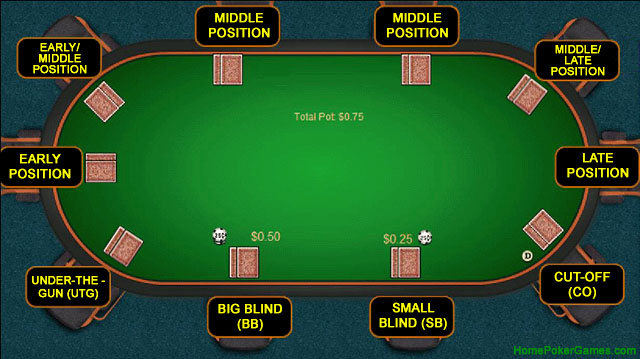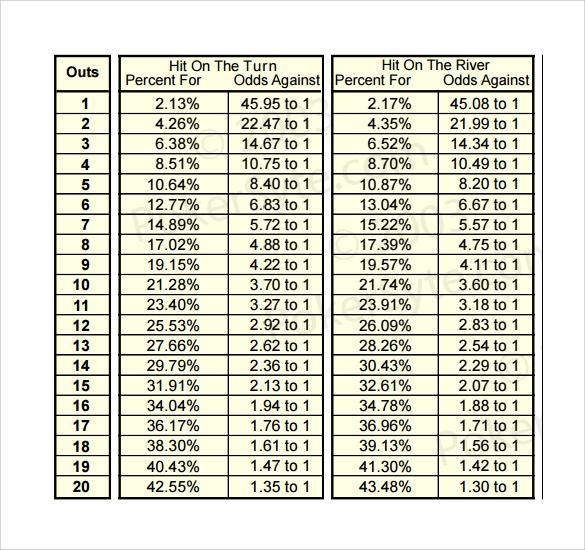Texas Holdem Poker Odds Table
Chances of hitting, flopping and holding certain hands
Texas Hold'em Odds 'Outs' are unseen cards that will make any hand you expect will win the pot if they come off on the turn or river. There are 47 unseen cards on the flop. To determine your odds of making your hand, you divide your number of outs by the remaining unseen cards (that will not help your hand). An outside straight draw has 8 outs. The odds in this Texas Hold'em odds table are unlikely to directly help your overall strategy, but they are pretty interesting nonetheless. The Texas Hold'em odds for each of the different situations have been given in both percentage and ratio odds, so use whichever format you feel comfortable with. Texas Hold'em Odds and Probabilities answers all of these questions and more. Every single decision you make at the poker table is in some way related to odds and probabilities. Whether you are deciding to bet, call, fold, raise, or even bluff, odds and probabilities are an integral part of the decision-making process. Know Your Poker Odds. We’ll get you started by showing you 20 examples of the basic Texas Hold’em odds you need to know. To really make a mark on the felt, we’re also going to show you a nifty little trick for calculating poker odds right at the table. Pocket jacks is known as a big danger hand in Texas Hold’em. It may look good, but the chances of a higher card turning up on the flop is 52%, giving your ‘fish-hooks’ less than half a chance of survival.
These odds are a must know if you want to advance your game to a high level. For exact odds you can check out our poker hand odds calculator. We rounded the number to the nearest decimal for you.
Texas Holdem Poker Odds Calculator
You should know what beats what in poker before trying to apply these odds or playing like you see poker on tv and in commercials.
| Scenarios – Chances of Having Certain Hands | Examples | Probability | ||
| Chances of Being Dealt | ||||
| Pair | 6h 6d | 6% | ||
| Suited Cards | Ah 10h | 24% | ||
| Connecting Suits | 2d 3d | 4% | ||
| Aces or Kings | AA KK | .9% | ||
| Ace King | AhKs | 1.2% | ||
| Ace King Suited | AhKh | .3% | ||
| An Ace | A3 | 16% | ||
| Cards Jacks or Higher not Paired | KJ | 9% | ||
| Not Suited & Not Connected | 9h 4s | .9% | ||
| Bad Beats | ||||
| Bad Beat ex: Aces vs Kings heads up | AA vs KK | .004% | ||
| Chances of Hitting on Flop | ||||
| Pocket Pair Into A Set | JJ into JJJ | 8% | ||
| Pair Turning Into A Set On Turn | 4% | |||
| Hitting Pair on Flop | 32% | |||
| Flopping Four To Flush-You hold 6h7h-flop comes-> | Ah Kh 2s | 11% | ||
| Chances of Board Coming All Same | 5h 5s 5d | .004% | ||
| Number of Players To Flop Odds | ||||
| Situation – Chances someone hit top pair on board | ||||
| 5 players see flop | 58% | |||
| 4 players see flop | 47% | |||
| 3 player see flop | 35% | |||
| 2 player see flop | 23% | |||
| After Flop – Chances of Making Hand | ||||
| Making open straight – You hold 67 Flop comes 8,9,2 | turn 10 | 34% | ||
| Two pair to full house – You- 47 Board 4,7,10 Turn –> | 7 | 17% | ||
| Hitting A Gut Shot Straight | 17% | |||
| Backdoor Flush – You have 1 spade – Board 2s4h8s | 10s 7s | 4% | ||
| Runner Runner Straight | 1.5% | |||
| Hitting Either Gut Shot Straight or Backdoor Flush | 21% | |||
| Pairing An Ace on Turn or River | 13% | |||
| Before Any Cards Are Dealt – Chances of Getting | ||||
| Royal Flush (All Spades) | AKQJ10 | .0002% | ||
| Straight Flush (Any same suits) | 56789 | .0012% | ||
| Four of a Kind (Quads) | 5555K | .0239% | ||
| Full House (Boat) | 33322 | .144% | ||
| Flush (all same suit) =>all hearts | 37K48 | .19% | ||
| Straight | 34567 | .35% | ||
| Three of a Kind | 555AK | 2.11% | ||
| Two Pair | AAKK2 | 4.7% | ||
| One Pair | 77253 | 42% | ||
| Don’t catch anything | 2854K | 50% | ||
Why Poker Odds Matter
Why Odds Matter To any good Texas Holdem players these odds come naturally. They may not know the exact percentage but they instinctively know their odds. Referencing this table is a great way to understand your percentages if you are a new player or if you want to calculate your pot odds.
We developed what we believe are the best formulas for calculating pot odds that you will find on the internet. It is the same way the pros calculate their pot odds and we also simplified it for those of you who are not that good at math. Check out the Pot Odds section.

Once the flop has been dealt in Texas Hold'em, you'll be able to count your outs and know how likely it is your hand will improve. That will tell you whether you should stay in the hand or fold.
You can figure out your outs and odds for any hand, but here is a quick and dirty list of the most common scenarios:
Texas Hold'em Cheat SheetOdds Based on Outs after the Flop

If after the flop, you have:
Two outs: Your odds are 11 to 1 (about 8.5 percent)
A common scenario would be when you have a pair and you are hoping your pair becomes a three-of-a-kind (a set).
Four outs: Your odds are 5 to 1 (about 16.5 percent)
A common scenario would be when you are trying to hit an inside straight draw (there are 4 cards of one number that will complete the straight) or you have two pairs and you hope to make a full house (there are three cards remaining of one number and two of the other).
Eight outs: Your odds are 2 to 1 (about 31 percent)
A common scenario would be that you have an open-ended straight draw. There are four remaining cards of two different numbers that will complete your straight, on the high end and on the low end.
Nine outs: Your odds are 2 to 1 (about 35 percent)
This is the common scenario when you have a flush draw. Any of the nine remaining cards of the suit will give you a flush.
Texas Holdem Poker Odds Chart
Fifteen outs: Your odds are 1 to 1 (about 54 percent)
A scenario for this is having a straight and flush draw, where either any of the nine remaining cards of the suit will give you a flush, while there are four cards remaining of each of two numbers that would complete a straight. However, you don't count the same cards twice as outs, so those of suit you hope to get don't count again.
The Rule of Four and Two
These odds only apply to counting both the turn and the river, so they assume you will stay in the hand until the showdown. Your odds are only about half as good for a single card draw, such taking the hit on the turn or taking the hit on the river. A common way of looking at the difference in the odds when you will be seeing two cards compared with one is called the Rule of 4 and 2.
After the flop, count your outs and multiply them by four to get your percentage odds. This doesn't give you an exact number, but it is quickly in the ballpark. With 15 outs, 4 x 15 = 55 percent you'll complete that straight or flush with the next two draws.
However, when you are calculating the odds that a single draw will improve your hand, you multiply the outs by two rather than 4. With 15 outs, 2 x 15 = 30 percent chance.